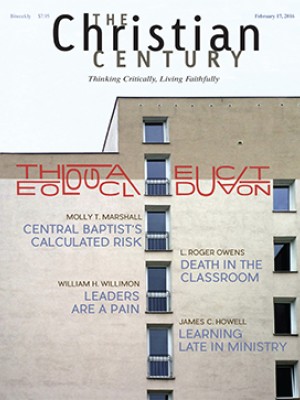Why leaders are a pain: Truth telling in the parish
There's a subtext to lots of sermons I hear, and some I preach: Discomfort is avoidable. Here's my formula. It's the promise of all bogus religion.

Recently I spent an hour with a young pastor who, six months after starting at a small-town church, discovered that the congregation was in greater difficulty—financially and demographically—than it had recognized.
“How do I tell them the truth without their hating me for it?” she asked.
We discussed strategies and issues of timing and presentation—much the same issues that a preacher confronts when preparing a sermon on a tough text. I was impressed with her determination to find a way to speak the life-giving truth that previous pastors had avoided.
Toward the end of our meeting, I said, “Just a couple of decades ago, ministers wouldn’t have had this kind of conversation. The church has handed us some hard work, work few of us expected and for which none of us is trained.”
She replied, “I thank God that I’m not only a pastor but also a mother. Motherhood has given me lots of experience in telling painful truths to people I love.”
This may be the first generation of pastors in centuries to whom God has given the intimidating assignment of not only loving but changing the church. When the San Damiano crucifix spoke to Francis of Assisi, it didn’t say, “Love everybody, particularly the birds.” Christ told Francis, “Rebuild my church.”
Read our latest issue or browse back issues.
That’s the task. One may criticize pastors at times for seizing upon secular leadership and management books, but at least give them credit for realizing that they have a daunting leadership task ahead of them—a job made more formidable because of the traits most pastors bring to the work.
In high school I worked in a failing sporting goods store. This youthful brush with business convinced me that I was unsuited for the commercial life. I realized that bosses must hire and fire people, cut costs, reprimand unproductive employees, and have uncomfortable conversations. I was too nice to do that. As a callow youth, I had the gross misapprehension that I could be a pastor without having to hurt anybody.
Twenty years later, knee deep in a congregational crisis, I read Ron Heifetz’s classic book Leadership without Easy Answers. Leadership is only necessary, he says, if an organization needs to go somewhere and is accountable to some mission more important than its survival. Many people in leadership try to be efficient managers rather than risk-taking leaders, because institutions crave the placidity of the status quo and reward those who keep them comfortable.
Caregiving, the default mode of most pastors, is always less costly than leading. But the problem with caregiving is that no group survives or thrives without continually refitting and repositioning itself—and certainly not an institution that’s accountable to a living God.
Speaking to the church of his day, G. K. Chesterton said that if you love how a fence post looks and want to preserve it, you must repaint it every year. A faithful church can’t be maintained without constant reformation.
One of Heifetz’s insights is particularly memorable to me: a real leader, he says, induces pain—the pain the organization has been studiously avoiding. The pain is induced, he said, in the faith that the organization has the resources to shape its future.
Pastors ought to know this lesson; it often surfaces in counseling sessions. How many times have I had a parishioner seek my counsel on a problem, and after listening empathetically, I foolishly ask, “Have you considered doing X?”
“I couldn’t do that,” comes the reply. “So and so would never allow me to do that.”
I then put forth a few more scenarios and hear about more obstacles and objections. Finally I say, “I can’t think of a way forward that would not require pain for you or someone else.”
“I’m disappointed in you, pastor,” grumbles the parishioner on the way out.
The promise of all bogus religion is the promise of a peaceful life without pain. That’s also the subtext of lots of sermons I hear and some of the ones I preach: pain is avoidable, and here’s my formula for living and loving without discomfort. To which Jesus might respond: What about the word cross do you not get?
Some of the best service that pastors offer arises when we dare to prod, preach, and pray a congregation toward the painful reality it has been avoiding. Yet how many of us went into the ministry in order to hurt people? We enjoy thinking of ourselves as peacemakers and reconcilers.
Jesus Christ embodied truth as well as love, and there’s no way to work for him without also being willing to put people in pain in Jesus’ name.
The day after the massacre at Mother Emanuel AME Church in Charleston, the governor of South Carolina foolishly said, “Let the healing begin.” No. There can be no healing of the sin of racism without honesty, confession, repentance, and the pain of truth telling and lots of hard work.
In a class on clergy leadership, one of my colleagues asked the students, “What is the most important thing pastors offer congregations?”
A seminarian replied, “Just to be present with people—listen, love, and stand with them.”
“That’s not good enough,” snapped back this professor of pastoral care. “You must have the courage to be a Christian caregiver. You can’t do that without being a truth teller. Individuals and congregations can’t get better unless somebody cares enough to help them hear and respond to the facts.”
Rabbi Edwin Friedman, author of A Failure of Nerve, contends that empathy is the great enemy of pastoral leadership. Empathy can be a form of pastoral self-protection, disguised as the desire to shield others from pain.
Visiting a church in Louisiana, I marveled at the turnaround that had occurred there in just a couple of years. I asked the lay leaders to tell me their story.
They told about the time they met with their bishop, Janice Huie, to discuss the profile of their next pastor. They reported how much they appreciated their current pastor. “We love him and he loves us,” one member said. “We hope that our next pastor will be as good.”
The bishop asked, “If he is so beloved, why has your attendance slipped by 20 percent in the last two years?”
They replied, “We didn’t know that.”
She said, “And you are the church’s leaders? You must have worked hard not to notice.” Then the bishop whipped out charts that showed the congregation’s rising age, declining giving, and lack of diversity.
“When she got through rubbing our noses in those stats,” said one member, “we were on our knees begging her to send us a pastor who knew not only how to love us but also how to help us.”
I admire Bishop Huie, who has taken on the difficult task of episcopal truth telling.
I once worked with a church consultant. “We want you to help us acquire a new vision for our congregation,” I told him.
He replied, “My task is to foster the difficult conversations you have either been avoiding or lack the leadership skill to begin.”
The most memorable moment of this consultation occurred when our visiting expert said, “You have a lovely, historic building that you have beautifully maintained. Unfortunately, this building was constructed for a congregation of 2,000. You can’t stay here with only 600 members. If you love this place, you must change.”
“None of what you need to do is risk or pain free,” he went on. “What doesn’t hurt won’t work. The good news is, I have faith that God has given you what you need to have a future.”
The consultant then told us to ramp up our children’s ministry, along with our program of inviting, welcoming, and recruiting members. We had already shown some promise in those areas. “You can do this!”
The consultant saved his final, painful thrust for me: “When I arrived yesterday, you disappointed me by giving me the trite, ‘I’m no micromanager. I hire good people and trust them to do well.’ That’s what managers say who either don’t know how to supervise others or think they are too good for that work.
“I shouldn’t have to tell you this, but none of your present staff will be able to lead the work that you now must do.”
I had read in a business book that “good leaders must have a high tolerance for pain,” but I had thought the writer was talking about a willingness to put others in pain. Sometimes the pain that’s required is your own. Much of the work I choose to do in ministry is the work that is less painful for me than the real work the church needs me to do. At church meetings, we often fight about issues of sexual orientation because that’s less painful than facing the truth about the church’s massive losses among people of all sexual orientations who are under the age of 40.
One reason that I continue to assert that preaching is the most formative and determinative of pastoral duties, the fount from which all theologically driven leadership flows, is that it also requires truth telling. If we can habitually stand in the pulpit and tell the truth of Jeremiah or Jesus, caring more about serving the truth than gaining the adoration of our congregation, we may be able to be leaders who tell our congregations the truth they’ve been evading.
A person leaving church one Sunday muttered to me, “I know that you would not intentionally hurt anyone, but I was hurt by what you said today in your sermon.”
I thought: Where would you get the notion that I didn’t want to hurt you? I’m a preacher! Luther compared the Word of God to a surgeon’s scalpel. The skills required to preach the gospel without flinching are marvelously transferable to the demands of leading congregations that seek to embody the gospel.
Søren Kierkegaard noted that many bright people in his age had blessed the world by inventing labor-saving devices. Kierkegaard declared that he would take a different path, the way of the Crucified: he would become a preacher devoted to making everyone’s life more difficult.
What a wonderful way to make a living.






